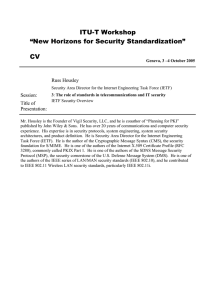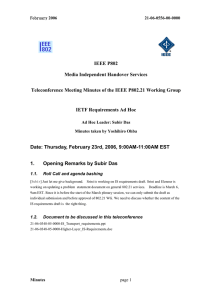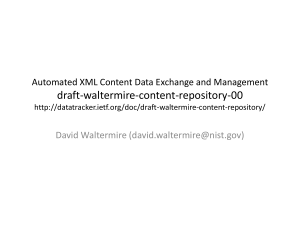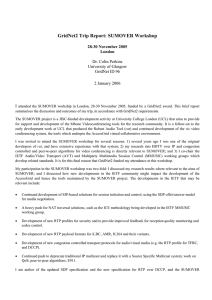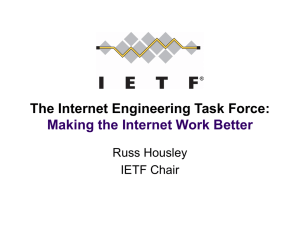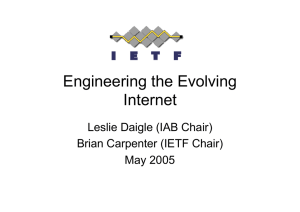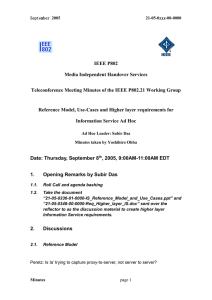Document 17772762
advertisement
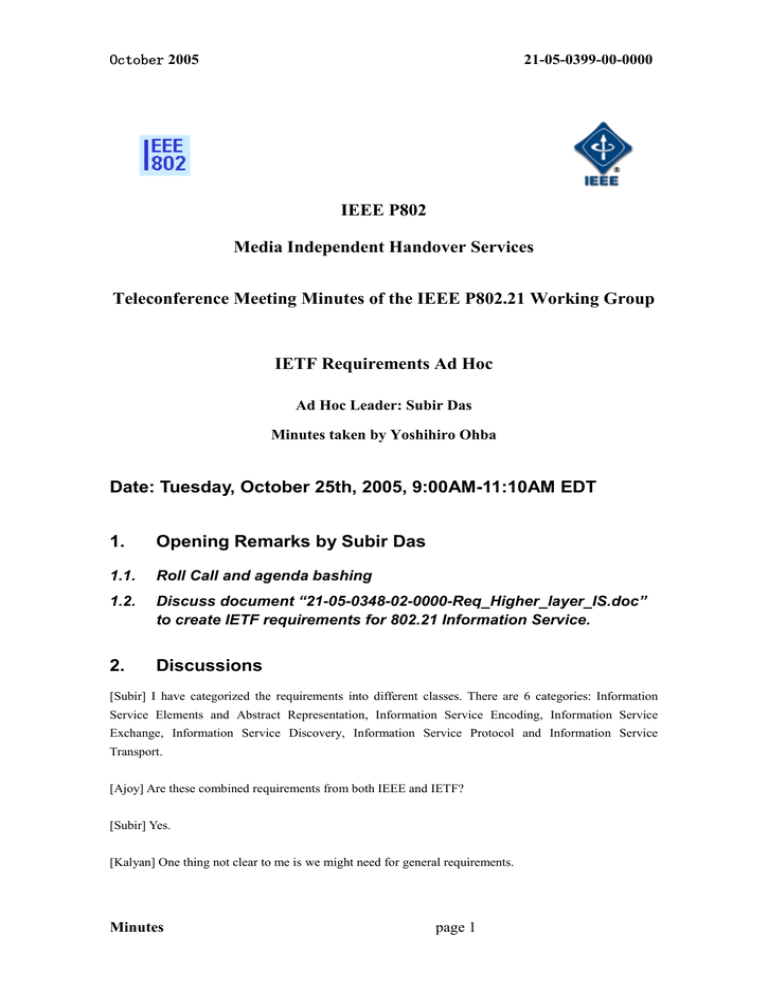
October 2005 21-05-0399-00-0000 IEEE P802 Media Independent Handover Services Teleconference Meeting Minutes of the IEEE P802.21 Working Group IETF Requirements Ad Hoc Ad Hoc Leader: Subir Das Minutes taken by Yoshihiro Ohba Date: Tuesday, October 25th, 2005, 9:00AM-11:10AM EDT 1. Opening Remarks by Subir Das 1.1. Roll Call and agenda bashing 1.2. Discuss document “21-05-0348-02-0000-Req_Higher_layer_IS.doc” to create IETF requirements for 802.21 Information Service. 2. Discussions [Subir] I have categorized the requirements into different classes. There are 6 categories: Information Service Elements and Abstract Representation, Information Service Encoding, Information Service Exchange, Information Service Discovery, Information Service Protocol and Information Service Transport. [Ajoy] Are these combined requirements from both IEEE and IETF? [Subir] Yes. [Kalyan] One thing not clear to me is we might need for general requirements. Minutes page 1 October 2005 21-05-0399-00-0000 [Subir] General requirements such as IP connectivity might be the basis on the higher layer requirements.. [Ajoy] In Req. 4.1.1, do we want to exchange media-independent information only over L3 or higher? [Subir] Everything specified in 802.21 should be media-independent. [Eleanor] Would you expect higher-layer information is only carried by higher-layer only? Media dependent part should also be included. [Subir] Do we care whether higher-layer carries media-independent or media-dependent information or both? [Eleanor] We don't care. [Subir] The IS server can carry media-dependent information as well. When we create requirements, if we combine the IEEE and IETF requirements, we need to consider media-dependent transport as well. [Ajay] I agree with Eleanor. IS transport is independent as to what information is carried. [Subir] If we delete the word "media-independent" from Req. 4.1.1, should it be fine?. If so, we will do that. [Kalyan] Are we defining the information elements? [Subir] Yes. [Vivek] Information organization and information elements should be separated. [Subir] We have IEs and abstract representation in the title. Do you suggest separating them? [Vivek] Yes. [Ajoy] Should abstract representation capture higher-layer information? [Subir] Yes. [Vivek] What is the purpose of this document? [Subir] The purpose is to identify all requirements that address all scenarios that we have discussed so far. [Srini] Is this for upper-layer information? Minutes page 2 October 2005 21-05-0399-00-0000 [Subir] What you mean by upper-layer information? [Kalyan] If we have all requirements in this document, then IETF might confuse as if all requirements should be supported in IETF. [Subir] I did not mention that we will bring this document to the IETF. [Ajay] Let me ask one question? Are there any other categories missing in the document? (Silence) [Ajay] OK, we have all categories. What transport implies? Some believes TCP and UDP type transport. Others think that transport includes "protocol". We could focus on requirements that IETF would need from us. [Kalyan] Trying to look at IETF requirements, then we also bring general requirements. This is confusing. [Ajay] Put this one as note. [Ulisis] Req. 4.2.2 is ambiguous. What is the definition of “efficient”? [Ajoy] I agree. [Ajay] Encoding is an integral part of transport, is that what you are saying? [Ajoy] Container protocol is to be defined in IETF, given that encoding is defined in IETF. [Ohba] Encoding should be defined in IEEE. [Ajoy] I agree that encoding scheme should be part of 802.21. On the other hand, how the encoded elements are carried in the protocol should be part of IETF. [Vivek] We need some sentence for each part of section 4 as to which should be done in IETF or IEEE. [Ajay] Which one should be dealt with IETF? [Eleanor] Section 4.4 is not part of IEEE. [Ajoy] Yes, and Section 4.4 has dependency on Section 4.6. [Ajoy] Why is NAT traversal for IS discovery ? Is it a requirement if we use DNS look up? Minutes page 3 October 2005 21-05-0399-00-0000 [Subir] Yes, you don’t need NAT traversal mechanism for DNS-based IS discovery. That is why we used "should". [Ajoy] What is information service discovery? Is that discovery of an IS server? [Subir] Yes, and in addition, discovery may include higher-layer IS as well. [Ulisis, Eleanor, Ajay] That is not IS service discovery. [Ajay] As general requirements, there is discovery requirement. There are several ways of discovering IS server, including static configuration. We can have a list of possible discovering methods. [Subir] We should not jump into any solution now. [Ajoy] We should ask IETF for dynamic discovery only. [Ajay] Section 4.4 may not require. Sections 4.5 and 4.6 should be sufficient. For example, static configuration should be described in 802.21. [Ulisis] Why we need to specify static configuration while it is implementation-specific? [Srini] Let IETF define the most suitable mechanism. [Srini] Sections 4.5 and 4.6 are relevant to IETF. requirements. Let's just state the requirements. The two sections are actually restating the same Once transport supports IPv4 and IPv6, the IS protocol does not need to distinguish the two. Do they have to be different or merged? [Kalyan] What exactly the transport and protocol mean? [Srini] We need to be clear about it. Is IP transport or protocol? Did we ever define the term IS transport and IS protocol in 802.21? Can we think of an existing transport that can meet all the requirements? There should not be any duplication for the two categories, e.g., Requirements4.5.5 and 4.6.8 seem to be duplicate. [Ajoy] In 4.6.2, support for both models should be part of Section 4.5. [Srini] In 4.5.1, regarding IS protocol header, there is no IPv4 or IPv6 specific fields in the protocol header in general. [Subir] I am fine with removing IPv4 and IPv6 hosts part in 4.5.1. [Ajay] What do you mean by securing transport? Minutes page 4 October 2005 21-05-0399-00-0000 [Subir] Think about TLS. [Ajay] This is not really transport layer? [Subir] If TCP is carrying IS protocol and TLS is present, then TLS over TCP is transport. [Eleanor] If we just describe that information service should be secured, then the details may be expanded by the IETF. [Subir] I agree but my understanding is that transport and discovery are defined in IETF. Protocol can be defined in IEEE. [Srini] Then, depending on the solution, if we might just need to ask TCP/UDP port number, then we might not need to go to IETF at all. We can give all information to IETF. They may decide which requirements are reasonable. [Kalyan] Protocol header, payload definition should be defined in IETF. [Subir] Several people have different opinions on this part. [Ajay] We can further divide the protocol into call flow and message format. Message format is header plus payload. For payload, a common encoding mechanism would be important for both L2 and higher layers. [Ajoy] Representation can be accommodated in both L2 and higher-layer. [Subir] If we don't define the protocol and encoding what is the purpose of 802.21 IS ? [Ajay] Should we separate call flow (message exchange) and how request/response is structured (message encoding). [Kalyan] MIH packet has a header. The header differentiates three services. [Srini] Message body has to be common to all L2 technologies and higher layer. Ideally one common encoding scheme is better. Should it be open? [Ohba] Contents itself could contain a generic header. [Ajoy] Container header can be defined in the IETF. [Ajay] IETF defines container with L3 specific headers. Contents carried inside the container can carry 802.21 specific headers and payloads. Minutes page 5 October 2005 21-05-0399-00-0000 [Srini] MIH header is defined IETF. [Ohba] Every protocol has some header. The header should be defined in each protocol. If we take a look at MIH protocol, it has its own header. In addition, there will be another header in transport protocol. We should understand this layering aspect. [Ajoy] Do you mean MIH header is defined in 802.21? [Ohba] Yes. [Ajoy] Why do we need to define two headers? [Ohba] To support both L2 and higher layer transports. [Ajoy] What about filtering? [Ohba] Filtering is a part of MIH protocol so, it should be defined in 802.21. [Nada] We have now two different opinions. One is based on clear layering in which message exchange is defined at both IETF and IEEE at different levels. The other is that IEEE defines message exchange and IETF does not. [Srini] I am capturing layering view. I can create a graphical view of the options. Can we establish an email discussion on this issue? [Ajay] Yes. [Subir] Once two options are captured and graphical view from Srini, we can discuss them in a smaller group. [Nada] We need the definitions: Minutes what is protocol and what is transport. page 6 October 2005 21-05-0399-00-0000 3. Action Items 3.1. Discuss possible options and start the discussion within the IS group and then identify the role of IEEE and IETF. 4. Attendees (More may have attended. Please send updates to Chair) Ajay Rajkumar Ajoy Singh Eleanor Hepworth Kalyan Koora Kenichi Taniuchi Mathieu Peresse Nada Golmie Srinivas Sreemanthula Subir Das Ulisis Olvera-Hernandez Vivek Gupta Yoshihiro Ohba Minutes page 7
